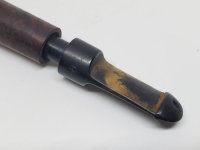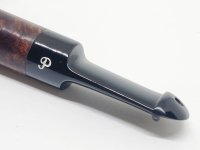Thanks, George.So, you're going to ignore gravitational effects and cosmic radiation, then...
Where is your committment, man?
I was going to sleep tonight.
Thanks, George.So, you're going to ignore gravitational effects and cosmic radiation, then...
Where is your committment, man?
What will you do with them?I just bought some of his rods. We shall see.
They'll wind up on my handmade pipes.What will you do with them?
Well mine get very little exposure to direct sunlight. But I don't oil them after each use, I could add that step in.Bingo! The discoloration (and the attendant bad taste/mouth and lip irritation) is due to the sulfur coming to the surface, an unfortunate chemical reaction that may be accelerated by exposure to sunlight. If memory serves, William Taylor used to boil the vulcanite used in the manufacture of his early pipe-stems in order to drive down the sulfur content, then finally switched to a material that he called "Ashtonite." According to Trent McCranie, Ashtonite was a material available in rods, and from which buttons were manufactured.
Ok. I'd guess mine may have gotten more exposure to bad lighting than to sunlight so I'll consider that as a potential culprit.Sunlight will definitely affect the vulcanine stems and cause them to oxidize, but as we discovered in our stores in the 1980s, fluorescent lights will do the same thing. If you have fluorescent lighting that your pipes are exposed to they can cause oxidation. We finally found a lighting specialist who came up with filters to put around the fluorescent tubes that eliminated the problem. They were basically just clear plastic tubes of some sort that filtered out the certain UV rays that caused the oxidation.
I have some pipes that are in excess of 70 years old that don't have oxidation problems and I have some much newer pipes that do have oxidation. Since I buy estate pipes, I often have to clean the oxidation off the stem and polish it and then treat it with obsidian oil. One of the best abrasives I have found is 3M polishing paper. It comes in various grits from 400 to 8000. The grits are much finer than regular sandpaper however. When I work my way through the grits from 400 up to 8,000 grit the stem is almost polished.
I use the polishing paper in my work on pocket knives. For pipe stems, I cut it in strips and gently clamp the pipe stem in rubber jaws of a vise and run the strip of polishing paper back and forth to remove the oxidation. When I have completed that process I have a special string wheel and a special plastic Polishing Compound that I use to put the final finish on the stem. I also use obsidian oil stem after every smoke. I keep my pipe racks in a steel cabinet in my shop where it is protected from direct light and absolutely no sunlight. I have been able to restore stems that were green and turn them into nice black stems that don't taste like sulfur. If I get in a hurry sometimes I will have to go back and go a little deeper with the abrasives but in general it works quite well.
Someone mentioned using toothpaste inside of the stem that is a good idea. I have used toothpaste to remove the tarnish from the outside of the stem but have not used it on the inside. I'm concerned it might leave a flavor in my stem that doesn't go well with my tobacco. I often use baking soda and water to remove scratches and oxidation from pocket knives and I'm sure it would work fine on vulcanized stems as well. At least it wouldn't leave a minty flavor.

I certainly hope so, as I've some new pipes with such stems that I haven't smoked yet but hope that when I do they won't deteriorate into unpleasant experiences.Without reading this entire thread, my only pertinent comment is that rubber making is probably a lot more consistent these days, and (depending on who makes it and where it is made) is probably better formulated to not have excess sulfur. It really was a seat-of-the-pants operation in days of yore, much like soap making.
My guess is that you buy stem rubber from China. I haven't had good experience with Chinese rubbers. And I have a strict One Child Policy.I certainly hope so, as I've some new pipes with such stems that I haven't smoked yet but hope that when I do they won't deteriorate into unpleasant experiences.
Ha.My guess is that you buy stem rubber from China. I haven't had good experience with Chinese rubbers. And I have a strict One Child Policy.
Ah, but where is the stem material made?Ha.
But I'm not buying Chinese pipes...
Actually wanting to primarily enjoy my new (& old) Petersons without concern.


Nice job saving that P, Al.Peterson vulcanite oxidizes more or less the same as any vintage pipe. This one is actually not bad, it must have been stored out of the sunlight after the owner stopped using it.
Exception, James Upshall - they used pre-cast vulcanite stems of a poor quality and by my experience, they oxidize quite rapidly compared to other makes.
View attachment 241496View attachment 241497
Upshall used the same source as Charatan, so no surprise.Exception, James Upshall - they used pre-cast vulcanite stems of a poor quality and by my experience, they oxidize quite rapidly compared to other makes.
Will do. Thanks.I have been using Charcoal Toothpaste for a number of years and find it great for a pipe smoker, a few years ago I tried it on my Vulcanite stems a they have never looked better and excellent for running a pipe cleaner through with it, I don't use anything else on them now, I'm in the UK but I'm sure you can get a Charcoal based Toothpaste in the USA, if you can try it.


